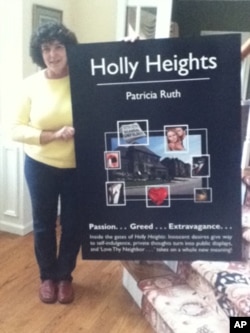More and more authors are taking control of their future by self-publishing their work. In fact, more books are self-published than are issued by traditional publishers, according to Bowker, which compiles publishing statistics.
Self-publishing means you not only write the book but take on production and sales as well. In earlier centuries, most publications were self-published, but over time the role of author and publisher became separate.
However, in the last few years, given the difficulty of finding a traditional publisher, a growing number of new authors have chosen to bypass traditional publishing and do it on their own.
"Holly Heights" is Patricia Ruth's first novel. “It’s a slice of suburban life and a story everyone can relate to,” she says.
After she finished writing and editing her novel, she was eager to see it in print. “I did try to go the traditional publishing route by sending inquiries to agents and publishers.”
It was a long, frustrating and, ultimately, unsuccessful process.
“I’m a member of a very popular club of authors that get rejected by agents and publishers," she says. "I’d get rejections from agents. It would come on a strip of paper, maybe two inches long, not even the courtesy of a full page letter. It’s outrageous the stuff you get back."
However, despite the setbacks, she was still determined to be published and a visit to a book fair inspired Ruth to do it on her own.
“I saw that there was so much going on with self-publishing and empowering authors," Ruth recalls."You know I felt it was very doable.”
The first step was to discover how to go about it.
”It’s as easy to start as just Googling the word ‘self-publishing’ and you’ll see that there is quite a number of companies that do provide self-publishing services," she says. "It's really very simple.”
CreateSpace, a subsidiary of Amazon, is one company which provides self-publishing services.
"One of the key challenges for authors is coming up with their cover," says Libby Johnson McKee, managing director of CreateSpace. "We’ve created a tool called ‘a cover creator,' which allows you to use some of our preformatted templates to create your own cover. Once your title is finished and ready for production, we then produce that book, print on demand."
However, marketing a book is often more challenging than writing it.
“My recommendation is to start local," Ruth says. "In my community, my local bookstore has a table for local authors. So it’s a matter of getting them to pick your book, maybe do a book signing. I did one. You want to write a press announcement and send it to local radio, TV and newspapers."
Self-publishing has its limitations, according to Lorin Rees of Rees Literary Agency. He represents authors to traditional publishers.
“Obviously self-publishing gives a lot of control to authors and allows them to fulfill their goals without having to go through a pretty difficult, tiresome and lengthy process and rejections," he says. "However, there are limitations to self-publishing particularly distribution, packaging, editorial support and credibility."
Margaret Hollister, who self-published "Inheriting China," a memoir about growing up as the daughter of missionaries in China in the 1920s and 1930s, agrees.
“It’s impossible, very, very stressful, so much work and so expensive," she says. “Maybe you write naturally. Maybe that’s a natural thing for you. Publishing and formatting a book and trying to find a market, all that, that is not natural. You need to learn that just as you would learn a profession.”
Editor David Minckler helped Hollister publish her memoir and warns others who want to follow her example to be prepared.
“I’d say they would have to learn some software and be pretty good at it," he says. "They should know enough to be able to scan pictures, organize a text and proofread.”
Digital technology has made it easier for authors, especially younger ones, to self-publish. However, Minckler believes writers will continue to prefer traditional publishers.
“A lot of self-published books seem to be pretty trivial and really not of much interest to a wide audience," he says. "So if you're talking about a wide audience, I think established publishers will continue.”
CreateSpace managing director Johnson McKee agrees that the traditional publishing industry will always be there. However, she believes self- publishing is here to stay.
“Since 2002, the growth of independent published books is over 8,000 percent," Johnson Mckee says. "So there is really a movement in the industry because anyone who wants to tell their story can be out there. I think that trend of democratization of the publishing process will continue.”
As more writers learn the process, Johnson McKee says it will become more affordable which, in turn, could attract more people to self-publishing.











